Mar 12, 2013 | installation, painting
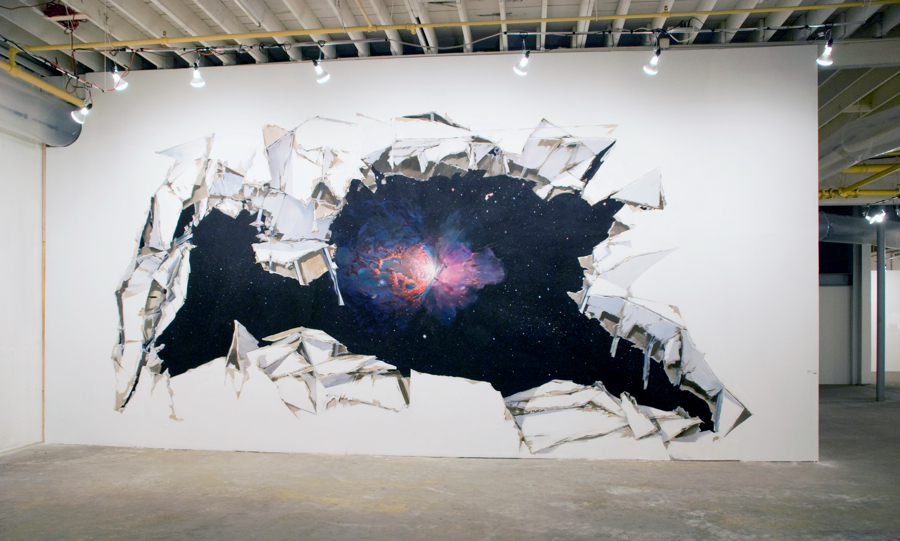
“Stardust,” 2010.
flash acrylic paint on tyvek
12 x 30 feet (144 x 360 inches) Image from artist’s website.
“Stardust” is a flash of make-believe, tricking your eyes into seeing something only found through a very powerful telescope or on the background of a Mac. The wall is painted like its falling apart, crumbling to reveal the image that’s breaking through behind. A star appears to be exploding – mid-transition on its way to becoming a white dwarf or a black hole – something other than what it used to be. With an asymmetrical form glowing bright, white light springs from the center while the rest of it shines red through the clouds that cover it.
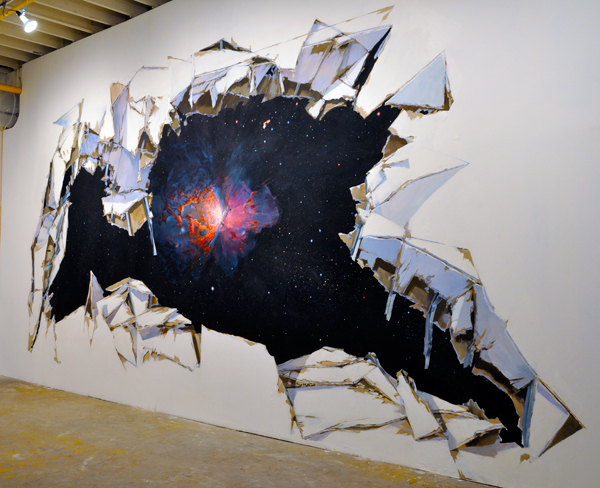
Image via Slow Show.
Adam Cvijanovic is a 54-year-old artist born in Cambridge, MA and now living in New York City. His work has been featured in the New York Times, Time Out NY, the New Yorker, along with ArtSlant, ARTnews, and Art Forum. He is currently represented by Postmasters Gallery in New York, and according to his CV he was continuously creating and exhibiting work from the mid-eighties until 2010, but hasn’t publicized making anything since.
For more of Adam’s work, see his Postmasters profile.
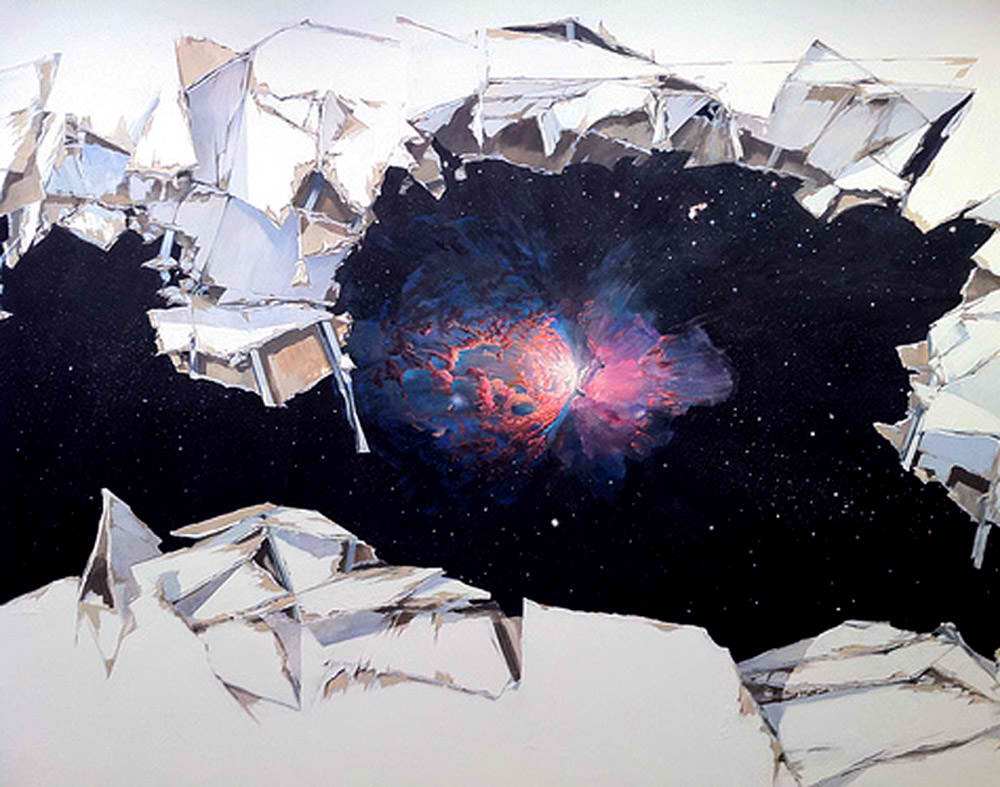
Image via Slow Show.
Feb 1, 2013 | installation, interviews, painting
 |
| Sophia Ainslie’s mural in progress on 1/30/13 at the Kingston Gallery |
On Wednesday I was lucky enough to meet with Sophia Ainslie, a South African artist who’s currently working on a mural at the Kingston Gallery in Boston’s South End. Right now I’m working on
an Artscope post about this new show “in person,” but I needed to write something else too because it was just so incredible to watch that mural come to life.
 |
| Mural with projection. |
Sophia had three trained assistants painting while I was there, two up on ladders filling in bright colored sections and one standing, tracing the lines coming from a projector. The projector contained a zoomed in section of the wall’s intended design, made with a computer that was used to combine works from “Fragments,” the drawing series Sophia has been working on for the past four years.
 |
| Sophia Ainslie (right) instructing an assistant. |
She made a number of murals from this same series last year, but this is the first time she’s ever used assistants. She told me she wanted to see how much of the work she could give away, kind of like Sol LeWitt but without giving it all up – more like Frank Stella she said. She wants the concept to be hers, but she was still very particular about how the assistants painted, she trained them and walked them through the process, overseeing the wall’s development every step of the way. “I’m a painter,” she said, “I’m seduced by the architecture of paint.”
 |
| Paper works for “in person” at the Kingston Gallery |
The lined sections of this feathered, almost camouflage-like design, were inspired by landscapes, but the ones seen beneath her feet so that she’s involved in what surrounds her. The colored bits are abstracted interpretations of her mother’s last X-ray, before she made the decision against surgery for cancer at the age of 82. Sophia has been developing this series since her mother’s passing in 2009, and now the horizontal large-scale medium of the mural is allowing for a release, “This is more about a letting go,” she said, “all the other images were vertical and more about the body. This is a release of her.”
 |
| Sophia Ainslie (right) instructing an assistant. |
 |
| Mural with finished design taped up. |
See more of Sophia’s work on her website here.
And read more about this show in my Artscope post!
Aug 25, 2012 | installation, MCA Chicago, sculpture
As you walk into the MCA’s architecture-inspired exhibit, Skyscraper: Art and Architecture Against Gravity, the first piece you see is Yin Xiuzhen’s Portable Cities: five open suitcases spread out along the floor.
Each contains a mini-skyline, small buildings made out of cloth – just like the clothes our suitcases carry. You can even see the tags on some of the clothes that make up rivers and lakes, and buttons in odd places. Most of the little buildings are built along the open flap, inside the body of the suitcase is a map of each city, viewable through a small lit hole.
 |
| Hangzou, China |
The blue-painted walls suit the yellow strings hung above. The strings map out the distance from one city to the next, forming a makeshift globe out of the three blue walls that surround the five suitcases. The string-suitcase combination makes for a beautiful scene, like a miniature world that can be thrown in the washer whenever it gets dirty.
Check out the rest of my Portable City pictures and others from the MCA here in my Flickr set:)
Feb 28, 2012 | installation, sculpture, The Whitney Museum
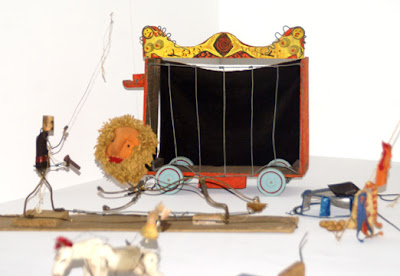 |
|
Lion and Cage from Calder’s Circus, 1926-31, from thecityreview.com |
Wire and fancy. That’s how I would describe this piece, or pieces rather. Three huge sets of miniature circus performers made of made of metal, wire, fabric, and yarn. A metal plated kangaroo the size of my hand rolls on ribbed washers. A clown wearing multi-colored layers topped by a lion coat has an almost ironically painted smile of red on his small wooden face. A lion with a plush face, yarn mane, and wire body is being tamed outside his cage by his wire-bodied master. And there’s tight-rope walkers, cowboys, acrobats, sword swallowers, everything expected of a circus setting, even the ringnmaster. I think I like it so much because there’s something about the idea of the circus that lends itself to being portrayed through this fanciful, although unglamorous, medium of wire.
 |
| Calder’s Circus, 1926-31, from the Whitney Museum of Art’s website. |
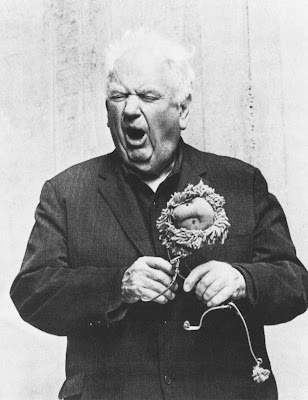 |
| Alexander Calder, Roaring with his Circus Lion, 1971, from kaufmann-mercantile.com . |











